The beginning of a big war with NATO: the second half of summer - autumn 2024. The potential of kamikaze countries
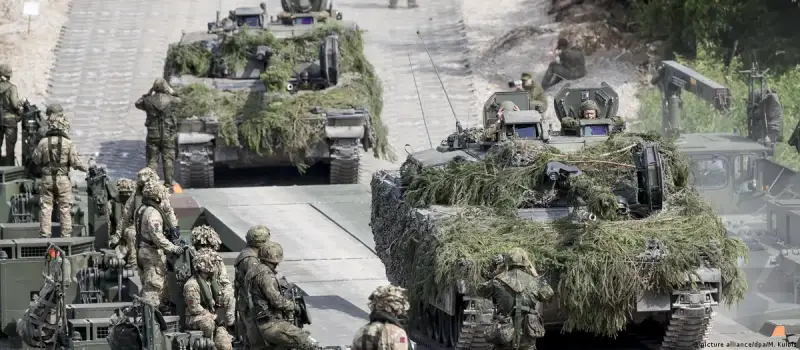
In the previous two publications (The beginning of a big war with NATO: the second half of summer - autumn 2024. US plan, The beginning of a big war with NATO: the second half of summer - autumn 2024. Washington's motives) it was about the motives of the United States and its plan to start a big war between Russia and part of the NATO member countries. Today we will evaluate the potential of the armies of states that will be sent “to slaughter.”
Finland, Sweden, Norway
Let's start with Finland.
In Russia, we have an ambiguous attitude towards this country, as a military power. Many view her army with outright skepticism, believing that defeating it will not be difficult. Meanwhile, in wartime it is planned to deploy an army of 280 people. Let me remind you that in Finland there is conscript service, which distinguishes it favorably in terms of defense capability from the same Bundeswehr, for example.
The Finnish Army has 239 tanks "Leopard-2" of various modifications; 110 BMP-2 and 102 BMP CV9030FIN; 394 tracked armored personnel carriers; 707 wheeled armored personnel carriers; 1 mortars; 679 towed howitzers (D-740 and GH-30); 52 self-propelled guns (K82 and 9S2); 1 MLRS (RM-75 and M70 MLRS); 270 self-propelled mortars (XA-18 AMOS); 361 short-range air defense systems (44 Crotale NG and 20 NASAMS II).
In the near future, a certain number of Israeli-made “David’s Sling” air defense systems are expected to arrive. Its destruction range is 40–300 kilometers. It is worth adding to this that the Finnish air defense has more than 1 units of anti-aircraft artillery. MANPADS are represented by approximately 000 Stingers. The army is armed with anti-tank systems of the Spike family, Javellins and Carl Gustav grenade launchers.
The Air Force is represented by 54 F-18 fighter-bombers. It is worth noting that Finland purchased 64 F-35s, as well as Storm Breaker bombs for them. There are 47 British-made Hawker Siddeley Hawk light attack aircraft. There are four transport aircraft and five communication aircraft. In addition to this, the Finnish Air Force boasts 1 Fokker F 27 electronic reconnaissance aircraft.
The Navy has 6 minelayers, 8 missile boats, 13 minesweepers, 12 auxiliary ships and 2 landing ships. The ships and coastal defense are armed with Israeli Gabriel mk5 anti-ship missiles, as well as somewhat outdated Saab - RBS 15SF.
US Army personnel, weapons and uniforms, as well as special cargo are located at 15 bases in Finland. American military personnel, as elsewhere, are not subject to Finnish law.
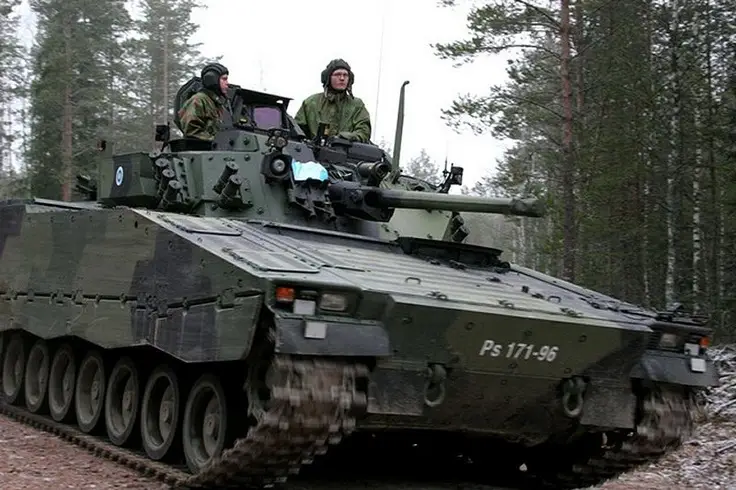
BMP CV90FIN
Sweden.
This country has traditionally been considered neutral, although its neutrality has always been a formality. Evidence of this is the activities of this state during the First and Second World Wars.
Sweden has a professional army, but military service has recently been introduced. In case of war, Sweden can deploy an army of about 30 people. Compared to Finland, this is not at all impressive.
The Swedish army is armed with 120 Strv 122 tanks (a Swedish modification of the Leopard-2 tank). There are 509 Strf 9040 infantry fighting vehicles; 334 armored personnel carriers and 380 armored vehicles Tgb 16 Galten. Artillery is represented by 154 self-propelled guns: AS08 and Gkpbv 90 (2–120 self-propelled mortar). 296 mortars.
Air defense is represented by 4 Patriot batteries with PAC-2 GEM-T and PAC-3 MSE missiles. Also, the skies of Sweden are guarded by an unspecified number of HAWK and BAMSE complexes. Recently, 16 IRIS-Ts have joined them. In addition to this, the Swedish army has at least 70 RBS 70 MANPADS, as well as 30 Lvkv90 (40 mm) self-propelled guns.
Military engineers have at their disposal about a hundred special vehicles, from self-propelled mine sweepers to tank bridge layers.
The Swedish Air Force looks more powerful than the Finnish. The kingdom has at its disposal 104 Gripen fighter-bombers, 13 transport aircraft, 4 AWACS aircraft, 20 Italian F-109M helicopters, 2 Black Hawks and 12 French Super Pumas.
As for the Navy, they are armed with: 3 Gotland-class submarines, 2 Södermanland-class submarines, 5 Visby-class corvettes, 6 Gothenburg-class corvettes, 12 patrol boats, 7 minesweepers, 187 landing craft boats, 1 radio intelligence ship and 15 auxiliary ships. The main anti-ship missile of the Swedish fleet is RBS-17.
For those who want to get acquainted with the Swedish armed forces in more detail, I recommend the article “Swedish Armed Forces: quality instead of quantity».
Norway.
Unlike Finland and Sweden, this country has been in NATO for quite a long time. In modern conditions, when the era of large armies somewhat unexpectedly returns, it is especially convenient for the United States for a clash with Russia due to its lack of nuclear weapons and the presence of conscript service, which allows it to count on a relatively large mobilization resource. This is especially significant considering that in Norway, conscript service is carried out by women. And if in peacetime 29 people serve, then in case of war, Norway plans to put 000 troops under arms.
The Ground Forces have a very significant number of H&K 416 automatic rifles, which the United States acquires exclusively for its Special Operations Forces. Armored vehicles are represented by Leopard-2 tanks (261 units), CV90 infantry fighting vehicles (164 units), and an unknown number of Tulpar infantry fighting vehicles. The Finnish Sisu XA-180 armored personnel carrier (75 units), the ACSV G5 tracked armored personnel carrier (119 units) and the American M113 (more than 288 units) are used. Armored vehicles ATF Dingo and Iveco LMV 2, LMV 3, LMV 4 - about 200 in number.
The units have 86 engineering vehicles of various types.
Artillery is represented by 69 self-propelled guns (K9 Thunder and 109A), 143 L16 mortars. Transportation of manpower and weapons is carried out by more than 7 trucks of various types.
The air defense forces are armed with 1 NASAMS III battery and 6 SHORAD ACSV complexes. It is characteristic that Norway has more than 80 radars of different types: from Ground Master 200 MM/C to Weibel Scientific XENTA-M.
The Norwegian Air Force currently has 30 F-16s and 28 F-35As. There are 4 C-130 transport aircraft, 4 P-3 Orion anti-submarine aircraft, 2 Falcon 20 electronic warfare aircraft. There are 41 helicopters of various types: from transport-combat NH90 NFH to multi-purpose Bell 412.
The Norwegian Navy, I believe, is also of some interest to us. The kingdom is armed with 6 diesel-electric submarines, 4 frigates, 6 corvettes, 6 minesweepers, 16 patrol ships, 2 reconnaissance ships.
Thus, summing up the results of the Scandinavian bloc, we can conclude that, according to the most conservative estimates, in the event of war, these countries will put together more than 600 soldiers and officers, 000 tanks, 620 infantry fighting vehicles, 885 armored personnel carriers and armored vehicles, 2 towed howitzers , 497 self-propelled guns, 740 mortars, 305 MLRS, 2 air defense systems, more than 118 units of anti-aircraft artillery.
The air forces of the three countries have at their disposal 216 fighter-bombers, 47 attack aircraft, 21 transport aircraft, 7 reconnaissance aircraft of various types, 4 anti-submarine aircraft and other vehicles, as well as 75 helicopters.
The navies of Finland, Sweden and Norway are armed with: 11 diesel-electric submarines, 4 frigates, 6 minelayers, 8 missile boats, 17 corvettes, 26 minesweepers, 16 patrol ships, 2 landing ships, 187 landing boats, 1 radio reconnaissance ship , 2 reconnaissance ships, 27 support ships.
This, I emphasize, is based on the most conservative estimates.
In my opinion, for quite a long time there has been an underestimation of the potential threat posed by these three countries. The neutral, pacifist northern powers, as these states were often portrayed, turned out to be not so harmless and peace-loving. And this is not just about their joining NATO.
For a very long time, the topic of pro-Nazi sentiments in these societies was studiously ignored.
Today, when states that were neutral in the past have chosen their own path, they have every chance of being the first to join the fire of a big war.
But we should probably stop there.
Let's move on to the second block - the Baltic countries.
Estonia, Latvia, Lithuania
Since I wrote in detail about the armed forces of these countries in the publication “War in the Baltics: American lambs on the sacrificial altar should not be underestimated“, I propose to immediately move on to their summary indicators of military potential.
In the event of war, 140 soldiers and officers will be deployed simultaneously in the Baltic countries. They are armed with: 000 tanks, 54 infantry fighting vehicles, 284 armored personnel carriers, all-terrain vehicles and armored vehicles, 3 towed guns, 814 self-propelled guns, 445 mortars, 163 MLRS, at least 1 air defense systems.
Aviation represented by literally a small number of transport aircraft.
The naval forces of these countries have in total: 10 minesweepers, 3 control ships, 1 minelayer, 18 patrol boats, 1 hydrographic vessel, 3 support ships, 4 multi-purpose patrol ships.
Of course, this number does not include the contingents of other NATO countries located in the Baltic states.
For example, 14 Challenger 2 tanks stationed in the Estonian city of Tapa remained behind the scenes. Or, for example, the air group of NATO countries in the Baltic countries.
By the way, a very interesting thing is happening with this group. It all started with 4 F-16 aircraft. Then their number increased to 8. Some time ago, F-22s were stationed on a regular basis in the Baltic countries.
Today, unfortunately, it is almost impossible to find in open sources the exact number of fighters regularly deployed in Estonia, Latvia and Lithuania. However, after comparing some things, we can assume that there are about 30 of them.
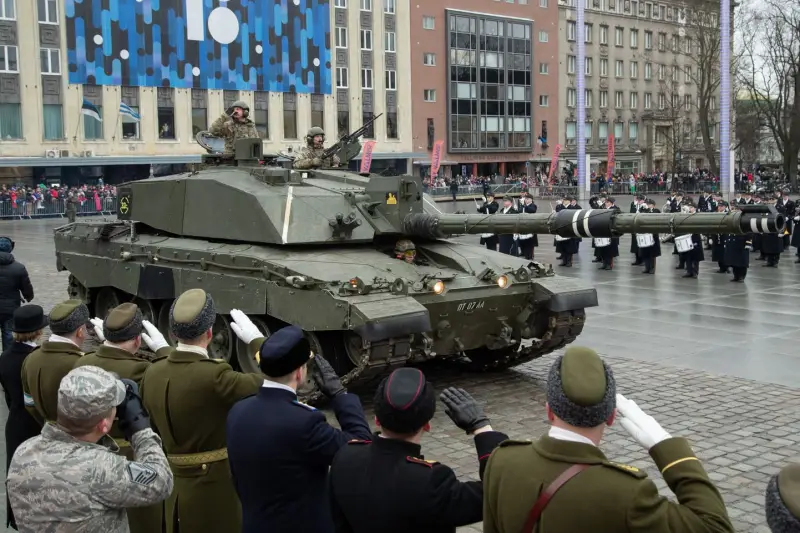
One of the Challenger 2 tanks at the parade in Tallinn (2019)
If we compare the Baltic group with the Scandinavian one, the Balts look completely unconvincing. The Finns, Swedes and Norwegians, having, by the way, certain claims to Russian territories (for example, Karelia or Murmansk), can try to succeed in the offensive, while the Baltic troops do not have such an opportunity.
But in any case, according to the plan of American strategists, they will fulfill their main task: they will divert a significant part of the Russian troops from the Ukrainian front.
In addition, at the beginning of the war, these armies will create a threat to the Kaliningrad region and Belarus, thereby interacting with Poland. At the same time, Blue Spear anti-ship missiles, already delivered to Estonia, will make it possible, in cooperation with the Finns, to block the Gulf of Finland, isolating the Baltic Fleet in Kaliningrad, and the installed sea mines will make the situation even more unpleasant.
If we return to the topic of the NATO contingent in the Baltic countries, its number today exceeds 5 people. It consists of a British armored infantry battalion armed with Challenger 000 tanks. Its location is Estonia. German armored units are present in Lithuania. Canadian infantry units are deployed in Latvia. There are also other divisions. In total, up to 2 NATO tanks can be deployed in the Baltic countries today.
On the one hand, of course, 5 fighters is not the number that could be called a “strike force.” However, it is precisely the limited number of NATO soldiers in the Baltic countries that indirectly once again indicates that these territories are being prepared for slaughter.
And, once again turning to the topic of business anticipation, I would like to note that this is confirmed by the move of the Tactical Foodpack enterprise, which produces dry rations for the military and tourists, from Estonia to Germany.
Very indicative for understanding the atmosphere prevailing in the Baltic states are the words of Kai Kallas, already mentioned today:
She said this in January of this year - two months before the conversation with Biden, after which she started talking about “suicide”...
And here a very interesting statement is made by Arestovich, who at the end of February this year, angry at the banality of his opponents’ statements, stated that Estonia, Latvia and Lithuania will have to fight with Russia not in 5-7 years, but in 5-7 months.
What is this - an accident or a slip of the tongue?
No, of course, Arestovich noted that Russia would attack Estonia because of a thirst for conquest (what about “aggressive” Russia), but what interests us here is not the motive, but the timing.
It is obvious to me that the Baltic countries will build their strategy on the expectation of help from other NATO countries. In parallel, they, with the help drones will attack infrastructure facilities deep in Russian territory - it’s not for nothing that Estonia purchased drones- “kamikaze” “Harpy” with a range of up to 1 kilometers. And Latvia, which has its own drone production plant, will not have a shortage of this type of weapon for some time.
I believe that the Balts realize that they were abandoned only in the ruins of their capitals. Their belief that Russia will invade their countries when it has accumulated enough ammunition will play a cruel joke on them. Not because there will be an invasion, but because it will actually be organized and provoked by their main allies - the Americans, as well as those whom they now welcome in their cities with open arms: fugitive Russian liberals and thugs from the Russian Volunteer Corps ( prohibited in the Russian Federation).
And yet one should not indulge in sweet illusions and hope for an easy victory. It is best if all this does not happen at all, and this is the responsibility of the intelligence services and diplomats.
Another thing is that there are situations when it is already infinitely late to do anything within the framework of “soft” power. The sooner this whole meat grinder ends, the better. But, of course, only by our victory.
Poland and Czech Republic
Armed forces Poland can field 250 people.
It is not without reason that the Polish army is called potentially the most powerful in Europe. The ground units are armed with 659 tanks (K2, M1 Abrams, Leopard-2, PT-91 Twardy, T-72). This number does not include tanks already transferred to Ukraine, as well as the Abrams M1 and K2 that have not yet been delivered. In the near future, another 96 K2 tanks and almost 300 Abrams are expected to be delivered.
The artillery consists of 927 self-propelled guns (K9, Dana-T, Dana-M, Krab, 2S1 Gozdzik, M 120 RAK). There are 824 K9 self-propelled guns in production. There are 211 MLRS units (K-239 Chunmoo, HIMARS, WR-40 Langusta, RM-70, “Grad”).
It is curious that out of 506 ordered HIMARS, only 18 have been delivered so far. The same story with K-239 - 288 have been ordered, only 14 have been delivered so far. The production of weapons at such a pace involuntarily makes one think that the manufacturer would not mind if the customer ceased to exist before receiving at least half of what was paid for, because the remaining products could be sold again to someone else. sell something.
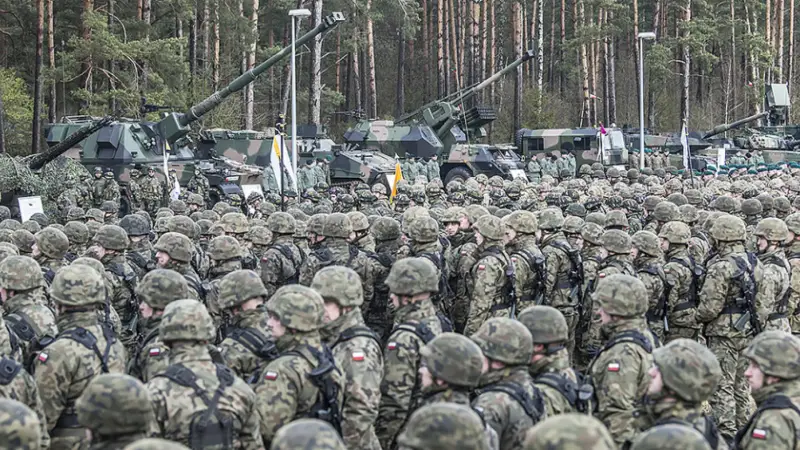
Polish troops are still in training
The motorized rifle units are armed with 1 infantry fighting vehicles and 617 mortars. The overwhelming majority of them are still Soviet-made. Almost a thousand Badger infantry fighting vehicles are in production. There are 1 armored personnel carriers and armored fighting vehicles of various types.
Air defense systems are represented by at least 169 air defense systems, most of which are outdated. Thus, the Polish army is still in service with about 50 9K33 Osa complexes, as well as 11 Kub complexes. Artillery-anti-aircraft systems are represented by the ZU-23-2, Gibernit, and Shilka systems. There are 436 units, some of which were transferred to Ukraine. In an effort to modernize its air defense system, Poland purchased 48 Patriot launchers and 644 missiles for them. This deal cost Warsaw $15 billion.
In addition, there are about 8 units of other equipment: trucks, engineering vehicles, tractors, gas tankers...
Taking into account the latest trends in military affairs, Poland has ordered more than 800 UAVs of various types and purposes.
Poland has also ordered 96 Apache attack helicopters, but has not yet received any. Of those already available, we can name Mi-24 (18), Mi-8 (27), Mi-2 (44), UH-60 (4), AW-149 (3), W-3 (38).
The Polish Air Force is armed with 12 SU-22M4K, 36 F-16C, 6 FA-50 fighters (38 are in production). On the eve of the start of the SVO, there were 22 MiG-29s, some were transferred to Ukraine, how many remained is unknown. In addition, Poland has ordered 32 F-35s, but not a single aircraft has yet entered service with the Air Force. It should be added that Poland has 78 training aircraft of various types, as well as 47 military transport aircraft.
If we talk about the Navy, they are relatively modest: 1 submarine, 2 frigates, 2 corvettes, 3 missile boats and 1 minesweeper.
In general, having briefly become acquainted with the nomenclature and quantity of weapons of the Polish army, one gets the feeling that, on the one hand, it really wants to arm itself thoroughly, and on the other hand, it is a toy in the hands of geopolitics. These huge orders that will take a long time to complete and cost a lot of money, this incredibly varied line of armored vehicles, air defense systems, aircraft...
Frankly speaking, Poland in some ways reminds me of Ukraine, only a little more of an order, but Washington’s attitude towards it is also extremely consumerist. And what can we say if they are preparing to throw the country into the crucible of war. And not just to send her to slaughter, but with an open desire to expose her to a series of tactical nuclear strikes. And if Russia does not do this, then Washington will do it, screaming, of course, that this is supposedly the work of the Russians!
It seems to me that all talk about the power of the Polish army is largely theatrical. Their goal is to convince the Poles that they are great warriors, chosen ones, capable of crushing any army. They did the same thing to them, only in a milder form, that was done to the Ukrainians.
But let's move on to Czech Republic.
The Czech Army is professional and has approximately 25 personnel.
They are armed with approximately 58 tanks (30 T-72 and 28 Leopard-2). There are 247 infantry fighting vehicles (120 BMP-2 and 127 Pandur II), 239 CV90 have been purchased, but none have yet been received. There are 141 armored vehicles. Artillery is represented by 98 field artillery pieces, as well as 110 mortars. The troops have 53 Dana self-propelled guns, they paid for the acquisition of 62 Caesar self-propelled guns, but none have been received yet. Carl Gustav grenade launcher, Javellin ATGM, Spike-LR are available. It is worth adding that the Czech Army has more than 3 trucks of different models.
The Air Force has 14 Swedish Gripen C/D fighters, 16 L-159 attack aircraft, 13 transport aircraft, 8 L-159 T1/2 trainers. There are 17 combat helicopters (Mi-24 and Mi-35), 5 multi-purpose Mi-17 and 30 transport helicopters (4 Mi-8, 16 Mi-171 and 10 PZL W3A). Air defense systems are represented by 8 2K12 “Kub” M2 complexes. 16 Israeli SPYDER complexes have been purchased, but none have been received yet. There are 32 RBS 70 MANPADS.
Thus, in total Poland and the Czech Republic can field at least 275 people. They are armed with 000 tanks, 717 self-propelled guns, 980 MLRS, 211 guns, 98 mortars, 1 infantry fighting vehicles, 724 armored personnel carriers and armored combat vehicles, 1 air defense systems (there is an unspecified number of Patriot air defense systems). The air forces of the two countries have at least 864 fighter-bombers, 1 attack aircraft, 170 training aircraft, 177 transport aircraft, as well as 68 attack helicopters and 16 other types of helicopters.
Romania
The Romanian army can field 125 soldiers and officers.
They are armed with 383 TR-85, 9 TR-580, 120 T-55 tanks (512 tanks in total). 54 M1 Abrams tanks have been purchased, but none have been received yet. There are 259 Piranha and MLI-84 infantry fighting vehicles. Armored personnel carriers are represented by a variety of models, numbering 956 units. There are 423 armored vehicles in service, also more than twelve types. There are at least 2 trucks.
The artillery is armed with at least 1 mortars and 670 towed guns. There are 720 MLRS (of which 225 are HiMARS). There are 36 anti-tank guns and 218 anti-tank systems (Malyutka and Konkurs).
The air defense has at its disposal 468 anti-aircraft gun systems (ZU-2 (60); M1980/88 (300); Gepard (36); Oerlikon GDF-003 (72)). In service there are 288 SA-94 and 48 SA-95 MANPADS based on the TABC vehicle. There are 16 Patriot complexes, 16 Osa air defense systems, 32 MIM-23 HAWK and 32 2K12 Kub air defense systems.
Thus, there are a total of 144 short-, medium- and long-range air defense systems. Unfortunately, there is no clear information about the UAV. But in fairness, it should be said that there is very little of it in relation to the armies of the other countries under consideration. Classic airplanes are another matter.
So, the Romanian Air Force is armed with 20 F-16s (29 more should be delivered), 21 IAR 99 attack aircraft, 19 transport aircraft of various models and 2 AN-30 surveillance aircraft. There are 14 YAK-52 trainers at our disposal. The helicopters are represented by 84 IAR 330 and IAR 316.
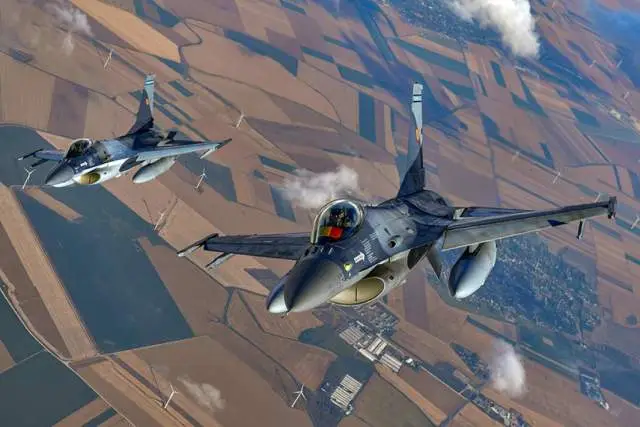
F-16 of the Romanian Air Force
Also in service are 5 RQ-4 Global Hawk UAVs and 7 RQ-7 UAVs.
The number of auxiliary vehicles is unknown.
The Navy has 1 submarine, 3 frigates, 4 corvettes, 3 missile corvettes, 3 torpedo boats, 6 minesweepers, 3 river monitors, 5 gunboats, 13 patrol boats, 16 auxiliary ships. They are complemented by 3 IAR 330 helicopters.
The coastal defense is armed with 4 Rubezh missile systems (R-15 Termit missiles).
It is characteristic that Romania is now awaiting deliveries of heavy weapons. Ordered: 298 infantry fighting vehicles from different manufacturers, 1 armored vehicles, 059 self-propelled guns (K90 Thunder, T-9 Firtina, Panzerhaubitze 155, ATMOS-2000), and, of course, 2000 F-48s, none of which have been delivered yet.
Of course, it would be naive to expect any special achievements from the Romanian army, but it is quite capable of occupying Transnistria or, for example, strengthening the Armed Forces of Ukraine.
An underestimated danger
Thus, the total armies of NATO countries, which with a high degree of probability will enter into conflict, number 1 people (this is if we count only military personnel simultaneously under arms. So, in Estonia, for example, the reserve numbers about 140 people, and according to The wartime armed forces number only 000 soldiers and officers).
They are armed with 1 tanks, 903 infantry fighting vehicles, 3 armored personnel carriers and armored vehicles, 292 guns, 8 MLRS, 860 self-propelled guns, 2 mortars, 221 air defense systems, 531 anti-aircraft gun systems.
Aviation includes 304 fighter-bombers, 84 attack aircraft, more than 100 transport aircraft, 345 helicopters and a number of other manned and unmanned aerial vehicles. As well as a very significant number of MANPADS, ATGMs, grenade launchers, and more than 15 units of auxiliary equipment. Some armies have at their disposal long-range kamikaze drones (up to 000 kilometers), as well as ATACMS missiles with a range of up to 1 kilometers.
This is only according to the most conservative estimates. Left out of the brackets are the contingents of other NATO countries located on the territory of these states, as well as their weapons. For obvious reasons, the forces of the countries of the North Atlantic Alliance are not taken into account, which with an extremely high degree of probability will be deployed in Ukraine in the very near future. And, of course, the forces of the Ukrainian Armed Forces are not taken into account.
In general, based on a rough estimate for now, we can assume that in August–October this year an enemy group of more than 2 million people will operate against the Russian Armed Forces from the Arctic Ocean to the Black Sea.
In this regard, it is certainly time to stop all the songs about “the last shell” and “the last cartridge.” Such ideas, disseminated by a number of media outlets, have an extremely negative impact on society as a whole and create a false idea of reality.
Yes, in Ukraine there may indeed be a lot fewer shells, but this does not automatically mean that their number has been reduced to the minimum number in the arsenals of NATO countries. I will never believe that, while planning this whole war, they did not deign to acquire sufficient ammunition. I am sure that all this is the most ordinary disinformation campaign from Western media.
In my opinion, any statements by Western leaders, politicians, public figures, journalists, and experts should be taken with exactly the same doubt. All this talk about freezing the conflict, about peace negotiations, as well as about some kind of fear of terrorist organizations that they allegedly experience after the terrorist attack in Moscow is nothing more than a blatant outright lie.
The feeling that we are underestimating the enemy, constantly trying to downplay his importance and danger, has not left me for quite some time.
Perhaps it is already clear that the enemy is extremely strong, that modern Ukraine is just a puppet in his hands. Considering the armies of the states indicated in the review as inferior, reasoning in the spirit of “they have nothing,” we have every prospect of encountering colossal difficulties on the path to Victory. But difficulties and difficulties will arise on their own, so let’s not aggravate them.
Something persistently tells me that Ukraine is just the beginning, no matter how sad it may sound. It will be a difficult, bloody and long war, but we have no right to lose.
And to do this, first you need to stop laughing at the armies of Finland or Norway. In my opinion, it is underestimating such enemies that gives them a chance to win. Of course, no one wants to use nuclear weapons weapon. And this means that we need to do our best to find leverage over these states, forcing them to peace. Nobody wants our guys to die holding back the onslaught of the Scandinavian hordes or the Baltic hordes, and this means that there should be less grins, inappropriate irony and sometimes outright nihilism under the guise of “this cannot be.”
Unfortunately, it so happened that at one time the Soviet Union collapsed. Today we are reaping the fruits of that disaster. We are paying for trust in the West, we are paying in blood for voluntary self-destruction and disarmament. We still have to learn the lessons of history, but I hope we have finally learned the main lesson today: no trust in the United States. Not at any level. No blind admiration for Western values, no glorification and idolization.
But at the same time, we, each of us, need to understand the power of the West. And its strength, in my opinion, lies in illusion. It was thanks to false ideas about himself that he managed to brainwash tens of millions of people and convince them to go fight for his interests.
Being morally bankrupt, the United States managed to form an elite completely under its control in European countries. Washington's vassals are routinely making empty statements. They change their rhetoric five times a day. But the main thing remains the same for them: they hate Russia, they hate us.
I would very much like to be wrong, but too many things point to the extremely high probability of a major European war in the near future.
Whether it will become a third world war depends not only on us. But it’s up to us and no one else to decide whether we should be winners or not.
Information